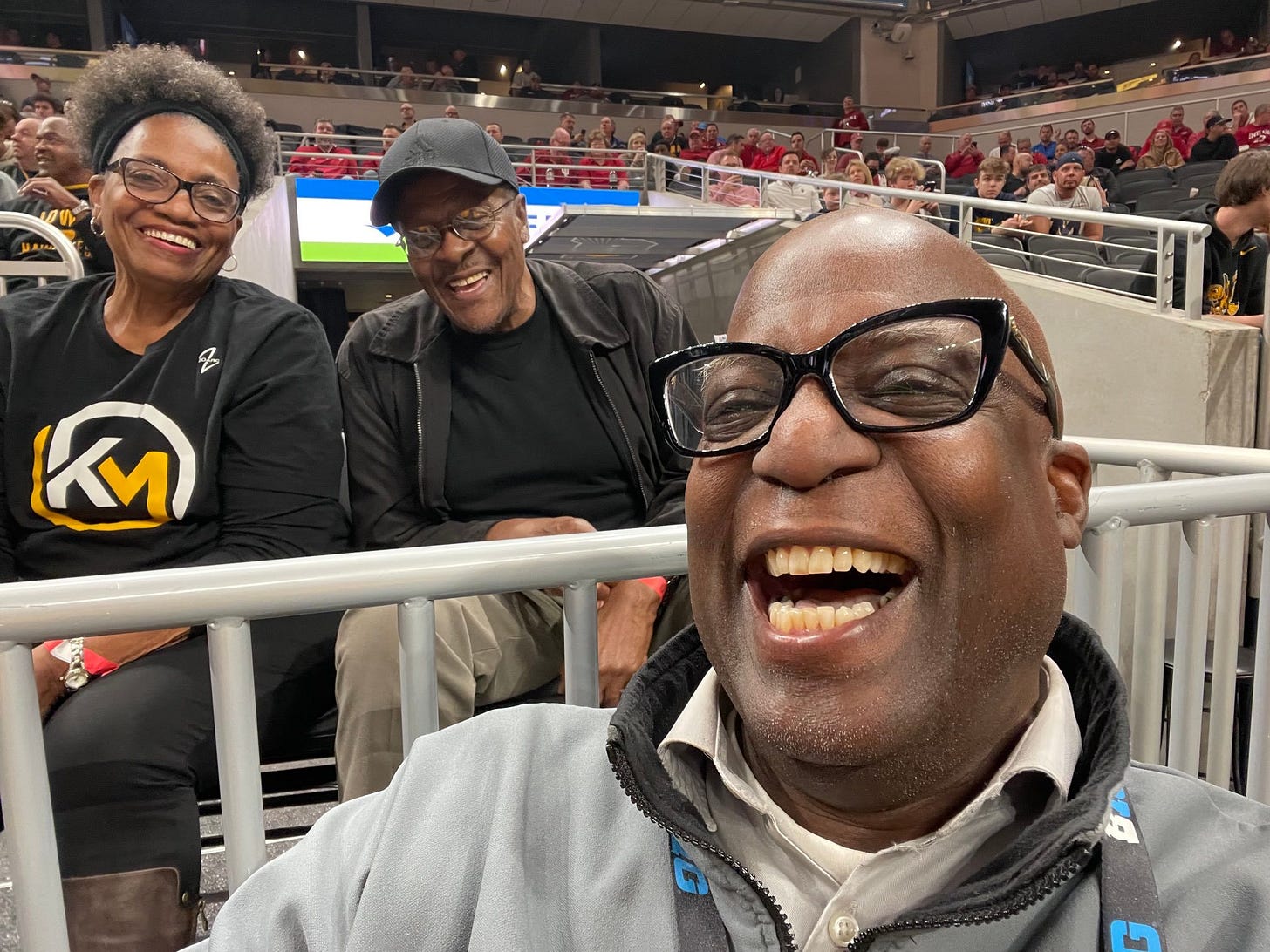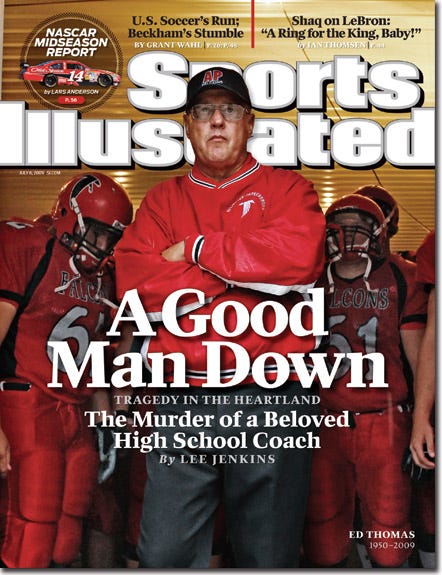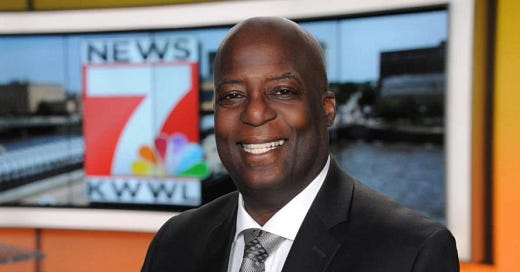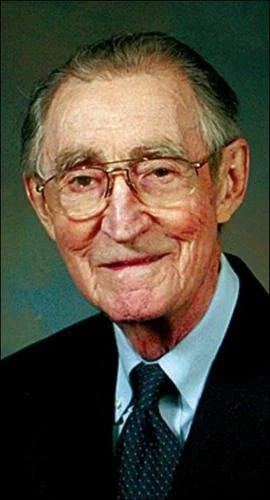An 'iron man' of eastern Iowa sportscasters
Rick Coleman marks 36 years at KWWL in Waterloo, 22 as sports director
Rick Coleman is hardly a shy fellow.
But for a guy who’s probably as well known as anyone around eastern Iowa, there’s one thing about him that is largely overlooked.
His longevity.
The affable sports director at KWWL-TV in Waterloo is probably the longest serving local newscast member in this neck of the woods in eastern Iowa not named Ron Steele.
Steele, Coleman’s broadcast partner, will mark his 50th anniversary at KWWL next year. But Coleman has a few notches on his belt too.
”I actually celebrated my 36th year as a full-time employee on July 6,” he said.
The fact that he’s Waterloo born and raised is a source of personal pride. The fact that he happens to be Black makes him a trailblazer in terms of his years served.
“I started working part-time in the KWWL Sports Department with Bob Hogue in 1979 - my senior year at Waterloo West (High),” Coleman said. “ I became the first McElroy KWWL intern in 1981,” funded by the R.J. McElroy Trust, the namesake trust of the station’s founder
“I started full-time at KWWL in 1987 as a reporter/news photographer. I was promoted to a weekend sports anchor in 1991 and I became the sports director in 2001. “

He ran track in junior high and high school and was good at math, but a junior high teacher noted Coleman’s vocal qualities and had him read school announcements over the intercom each morning.
”The light went on for me,” Coleman said. “It planted a seed that continued. This person saw something in me and encouraged me. And she didn’t have to. ”
The teacher even noted Coleman had a future as a radio broadcast announcer of KWWL; that was when the parent company had TV and radio stations with identical call letters.
”When you encourage a young person like that - I was going through a lot of struggles socially, still trying to find my place in this world - she helped me at least find the confidence to move through it. Find confidence within myself. Have some self worth.
”I’m a darker skinned African American,” he added. “That wasn’t very fashionable back then. There was colorism that existed. For a long time I never thought I could be an anchorman on television. That was something that didn’t exist back then. Especially not for a darker skinned African American.”
It’s made him a role model, for better or worse. “That’s tough, because I’m not perfect,” he said. “The one thing I want you to take from me is that anything is posible if you work at it and want it…There’s opportunity here for African Americans. You’ve got to seize it. Take advantage of it.”
And he’s comfortable in the Cedar Valley
”I was meant to be here,” he said. “I’ve had opportunities to leave here. But it wasn’t meant for me to leave. It was meant for me to stay. One thing I try to do is do the right thing and send the right message. Some leave for money. I didn’t want that.” Waterloo “has gone through some difficult cycles, but it’s like any other community. It’s a community that’s growing.”
Coleman received his degree in communications studies from the University of Iowa.
While a self-admitted sports junkie, he received a solid grounding in news reporting under the mentorship of Grant Price, the venerated late longtime KWWL news director who had a long career at rival station WMT, now KGAN, in Cedar Rapids before coming to Waterloo in the early 1970s. At KWWL, Price formed a solid staff of journalists including Steele and Liz Mathis, later an Iowa state senator — and a diverse staff that included Black journalists like Trace Regan, Roy Walker and Kelly Jackson in addition to Coleman. Price also taught at Wartburg College in Waverly.
“He’s the standard bearer for me,” Coleman said of Price. “No one’s ever topped his stature or relevance to me. He was the truth seeker and the truth teller. Before you hit the air, you had to make sure you had all your ducks in a row in terms of information, in terms of both sides of the story. He instilled something in me. Every time I go on the air, I have to make sure my “T’s” are crossed and my “I’s” ar dotted. He forced me, just by challenging us every day in that newsroom.
”He took me under his wing.” Coleman said of Price, who passed away in 2008 at age 85. “I started believing in myself when he’d start to nod his head and say, ‘You’re coming along here, Rick.’ “ Coleman did a considerable amount of behind-the-scenes videography and detail work in addition to reporting and proved himself worthy of an anchor opportunity.
Coleman liked his progression to hurdles in track, which he excelled in at West High. “I always felt as I grew in this industry and this business, as long as I kept him (Price) in mind at the finish line, that I was doing the right thing. He was tough. He wasn’t a flashy guy. He came out of radio; the written world was important. He wanted to make sure we told stories, and they were factual. We made sure we were telling the facts, both sides of the story; made sure you didn’t interview just one person, if there were more angles to cover.” Once he had proven himself with Price, as any other member of the staff had to do, that brought on a wellspring of confidence in dealing with anyone in the community.
However, ”being a news reporter in this community was both a blessing and a curse,” Coleman said, because he felt for his community and understood the impact of a story beyond simple observation. While he knew the community and had access others may not have, “It was difficult, because I saw this was the plight of my community. It was difficult to go out and cover some of these stories.”
In the context of Coleman’s sports coverage, one of the most difficult stories he him to cover was the 2009 shooting death of legendary Aplington-Parkersburg High School football coach and community leader Ed Thomas by a mentally ill former student.
”That was one of the worst days of my life,” he said, still holding back emotions. When the initial report was received, “I didn’t want to believe it,”
Coleman had built a strong working relationship with Thomas, whom he’d covered through a challenging school merger, the success of many former students in the NFL, and how Thomas led the town’s recovery from a 2008 tornado that claimed the lives of nine people there and in nearby New Hartford.
The coach had been rumored to have died in the tornado, but Coleman quashed that report when he headed over to Parkersburg and found the coach cleaning up storm damage. He hailed Coleman with a hearty hello.
”Coach was a good man,” he said. “He was an incredible guy - an everyday common man who did great things.”

In contrast, one of the most exhilarating stories was the success of NFL Hall of Famer Kurt Warner, the University of Northern Iowa quarterback from Cedar Rapids Regis High School who went from sacking groceries after his college career to winning a Super Bowl with the St. Louis Rams. Coleman had covered Warner at UNI. When Rams starting quarterback Trent Green went down with an injury, Coleman, realizing Warner had a shot to start, headed to Rams training camp and got an interview with head coach Dick Vermeil, who told him, “We’re gonna rally around Kurt Warner.”
Warner led both the Rams and the Arizona Cardinals to Super Bowls nearly a decade apart. He and wife Brenda also helped with 2008 flood relief and home construction in Cedar Rapids as well as Cedar Falls. That earned Warner the Walter Payton NFL Man of the Year award the same day he played in the Super Bowl with the Cardinals.. And when Warner arrived in Canton, Ohio for induction into the Pro Football Hall of Fame in 2017, he spotted and and embraced a waiting Coleman.
”He had the talent, and we knew he had the talent,” Coleman said. “He had to have the right people in the right place at the right time. It was like a dream. I watched that whole thing happen and it couldn’t have happened to a nicer person. There was nothing that was going to stop him from achieving, given the opportunity.”
Which, he said, is a lesson for all of us.
”I know who I am. This is my job,” Coleman said. “I don’t say my job puts me ahead of anyone, in any way. This what I just like to do. I was able to do all right with people.” And, he said, in an era beset by misinformation, generated in large part by social media, good journalism is even more important now.
“Being in this business, as a journalist, it’s still about getting your facts straight, telling the truth, doing the research. Instead of being just the first to report something, being the first one to report it right,” Coleman said.
“And in terms of myself, I think there are a lot more opportunities than when I first came into this business” for journalists of color, he said. He holds late ABC News anchor Max Robinson as an inspiration, among others.
Pat Kinney is a freelance writer and former longtime news staffer with the Waterloo-Cedar Falls Courier and, prior to that, worked several years at the Ames Tribune. He is currently an oral historian with the Grout Museum District in Waterloo. His “View from the Cedar Valley” column is part of “Iowa Writers Collaborative,” a collection of news and opinion writers from around the state who have worked with a host of Iowa newspapers, news organizations and other publications.
The Iowa Writers’ Collaborative






What a wonderful, insightful look at the life and career of this eastern Iowa MVP -- Rick Coleman. Terrific reporting & writing job, Pat Kinney. I crossed paths with Coleman many times over our careers, but I’ve never had an opportunity for a good personal visit. Now I feel almost like I’ve had one.
This column put me back to so many names, events I recall. Spent 50 years in Blackhawk County and taught Rick Coleman. His charm and chatter made him the fun person you write about. He Clearly chose a profession and life that allow him to achieve the success he deserves. The first time I watched his sports report I remember thinking “of course this is perfect for Rick!”